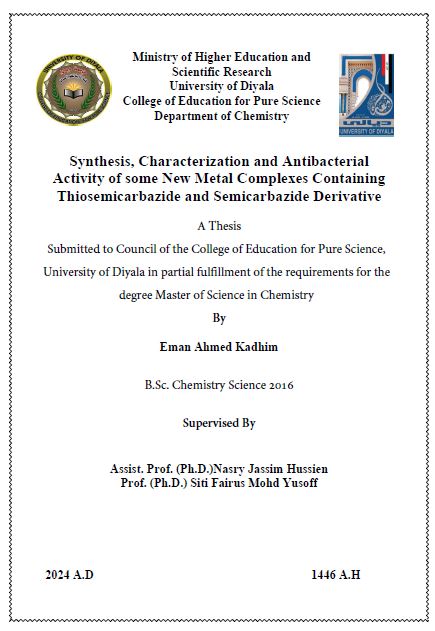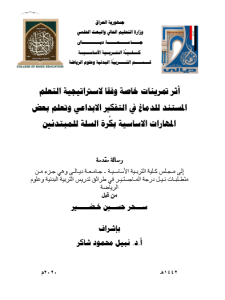المستخلص
This study presents the synthesis and characterization of two new thiosemicarbazide and semicarbazide ligands of N1-cyclohexyl-N2-(dimethylcarbamoyl)hydrazine-1,2-bis(carbothioamide) (L1). and N-cyclohexyl-2-((dimethylcarbamoyl)carbamothioyl)hydrazine-1-carboxamid(L2).Two-step synthetic procedures were used to obtain the previouslymentioned ligands. The first step included preparing the starting materials, N_cyclohexylhydrazinecarbothioamide for L1 and N_Cyclohexylhydrazine carboxamide for L2. The second step included the reaction of ammonium thiocyanate with dimethyl carbamoyl chloride using the solvent methanol, and a filtrate was obtained from this step, after whichThe starting material mentioned in the first step was mixed with the filtrate of the second step and the mentioned ligands were obtained The general formula of the ligands is;
[MCl2(H2O)(L1)];[MCl2(H2O)(L2)] Where M=(Mn+2,Co+2,Ni+2,Cu+2) All the mentioned ligands were characterized using Mass spectroscopy, UV-Vis, NMR (1H and 13C) A number of transition element complexes were prepared and characterized by reacting the aforementioned ligands with chlorides of metal ions, Mn+2, Co+2, Ni+2, Cu+2, , where a metal:ligand reaction was performed in a 1:1 mole ratio using the solvent methanol to obtain the complexes the following formula;
[MnCl2(H2O)(L1)]C1,[CoCl2(H2O)(L1)]C2,[NiCl2(H2O)(L1)]C3,[CuCl2(H2O)(L1)]C4, [MnCl2(H2O)(L2)]C5,[CoCl2(H2O)(L2)]C6, [NiCl2(H2O)(L2)]C7, [CuCl2(H2O)(L2)]C8,
and all the prepared complexes were also characterized using FT_IR, UV_Vis, elemental analysis (C.H.N.), measurement of molar conductivity, melting points, and magnetic susceptibility measurements. Measurements of the molarconductivity value of the complexes in the DMSO solution indicate Its non-electrolyte behavior agrees with the values of the magnetic moment.
The study showed the expected shape of the complexes Mn+2, Co+2, Ni+2, and Cu+2, which is a distorted octahedral, and the biological effectiveness of the ligands and complexes was studied against two Gram-positive (G+) (staphylococcus aureus) stain-negative bacterial isolates Escherichia coli (G-) for Gram stain by diffusion method. L1, C3, C2, and C4 showed good effectiveness against positive bacteria but did not show good effectiveness against negative bacterial isolates.




